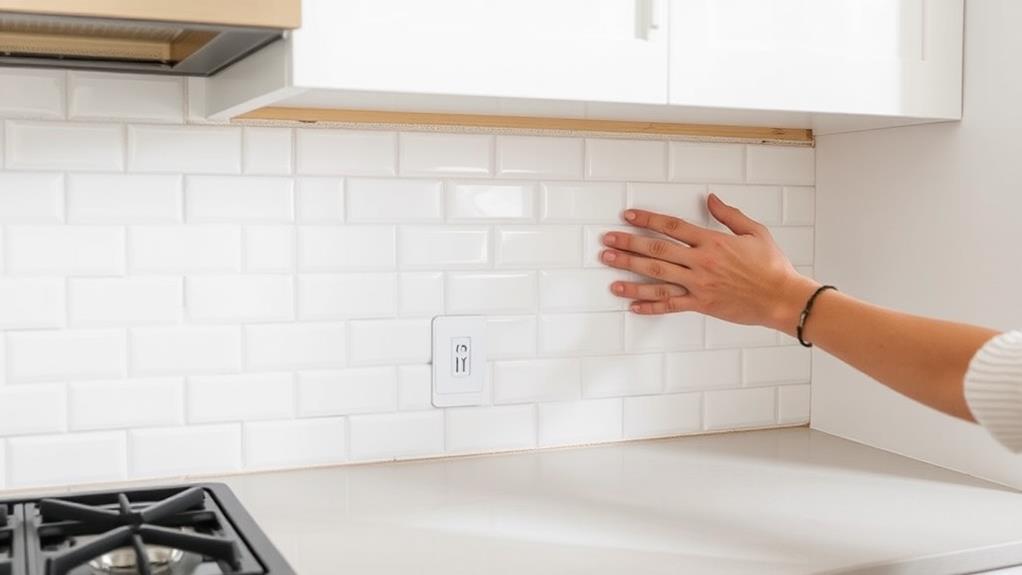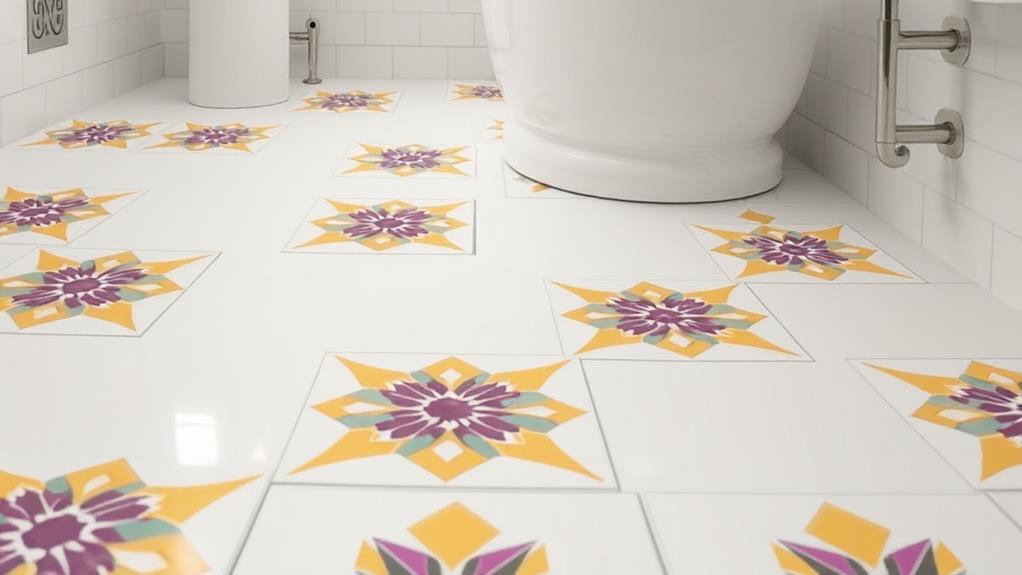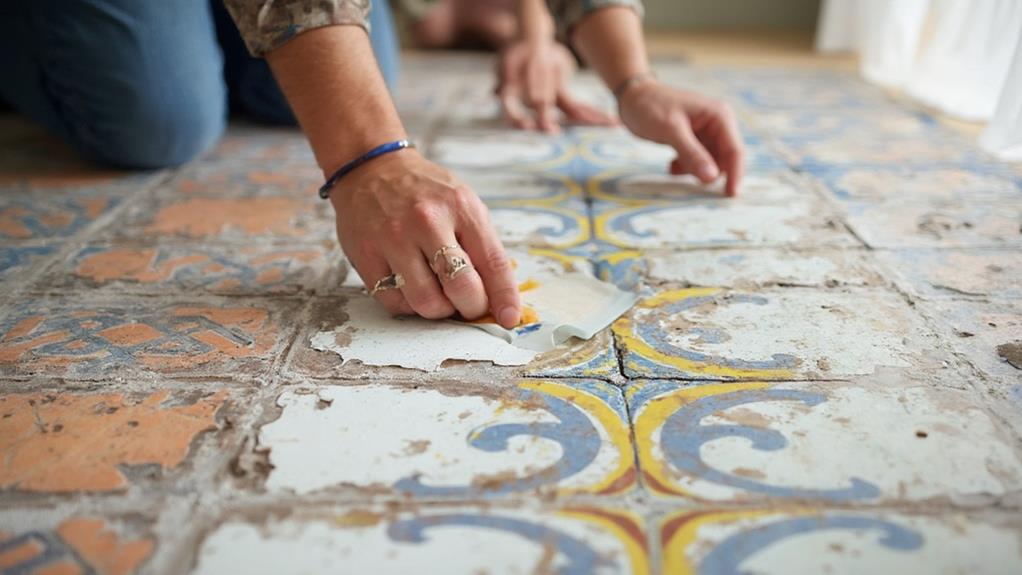Tile transformations offer budget-friendly solutions to refresh outdated floors and walls. Homeowners can paint tiles for an instant update, stencil patterns for added visual interest, or apply peel-and-stick overlays for a quick makeover. Grout refresh and recoloring can breathe new life into existing tiles, while decals and transfers provide temporary design options. These affordable techniques allow for customization and personal style without extensive renovations. From DIY-friendly projects to professional services, there are numerous ways to revitalize tiled surfaces and enhance the overall aesthetic of a space. Exploring these creative options can lead to stunning results that won't break the bank.
Painting Tiles for Instant Impact

How can you breathe new life into tired tiles without breaking the bank? Painting tiles offers an affordable and immediate solution to transform outdated surfaces. This DIY-friendly approach can revitalize floors, walls, and backsplashes with minimal effort and expense.
Begin by thoroughly cleaning the tiles and grout lines to ensure proper paint adhesion. Sand glossy surfaces lightly to create a better bonding surface. Apply a high-quality primer specifically designed for tile surfaces, allowing it to dry completely. Choose a durable paint formulated for tile applications, such as epoxy or chalk paint. These specialty paints resist moisture, wear, and cleaning products.
Apply the paint in thin, even coats using a foam roller or brush. For intricate designs or patterns, use stencils or painter's tape to create crisp lines. Allow each coat to dry fully before applying subsequent layers. Once the final coat has dried, seal the painted surface with a clear topcoat for added protection and longevity.
Consider painting select tiles to create accent patterns or focus areas. This technique can add visual interest without overwhelming the space. Remember that while painted tiles can dramatically improve appearance, they may not be suitable for high-traffic or constantly wet areas.
Stenciling Patterns on Existing Tiles
Stenciling patterns on existing tiles offers another creative and cost-effective way to revitalize your space. This technique allows homeowners to add intricate designs and personalized touches to their tile surfaces without the need for expensive replacements. With a wide variety of stencil patterns available, from geometric shapes to floral motifs, you can easily transform plain tiles into eye-catching focal points.
To begin stenciling, clean the tile surface thoroughly and apply a primer if necessary. Choose a stencil design that complements your decor and secure it firmly to the tile using painter's tape. Use a foam roller or stencil brush to apply specialized tile paint in thin, even coats. Remove the stencil carefully and allow the paint to dry completely before applying a clear sealant for durability.
Stenciling works well on both floor and wall tiles, making it versatile for various areas of the home. Consider creating accent walls in bathrooms, adding interest to kitchen backsplashes, or updating outdoor patio tiles. With patience and attention to detail, even DIY beginners can achieve professional-looking results, breathing new life into tired tile surfaces at a fraction of the cost of replacement.
Peel-and-Stick Tile Overlays

A revolutionary solution for quick and affordable tile makeovers, peel-and-stick tile overlays have gained popularity among homeowners and renters alike. These adhesive tiles offer a simple way to transform outdated or worn surfaces without the need for extensive renovations or specialized skills.
Available in a wide variety of designs, colors, and patterns, peel-and-stick tiles can mimic the look of ceramic, porcelain, or even natural stone. They are typically made from durable vinyl or gel materials that resist water and wear, making them suitable for use in kitchens, bathrooms, and other high-traffic areas.
Installation is straightforward: clean the existing surface, measure and cut the tiles to fit, then peel off the backing and press them firmly into place.
While not a permanent solution, these overlays can last several years with proper care and maintenance. They are particularly appealing to renters who want to personalize their space without damaging the original tiles. However, it's important to note that some adhesive residue may remain upon removal, and the tiles may not adhere well to textured or uneven surfaces.
Despite these limitations, peel-and-stick tile overlays remain an attractive option for those seeking a cost-effective and temporary tile transformation.
Grout Refresh and Recolor
One often overlooked method for revitalizing tired tile surfaces is grout refresh and recolor. This cost-effective technique can dramatically transform the appearance of tiled areas without the need for full replacement.
Grout lines that have become discolored, stained, or worn over time can be restored to their original hue or even updated with a new color to complement modern décor.
The process typically involves cleaning the existing grout thoroughly, then applying a specialized grout colorant or sealer. These products not only refresh the color but also provide a protective barrier against future staining and moisture penetration. DIY kits are available for homeowners comfortable with the task, while professional services offer more comprehensive treatments and expertise.
When selecting a grout color, consider the overall design scheme of the space. Lighter colors can make a room feel larger and brighter, while darker hues can add depth and contrast. For a subtle update, choose a shade close to the original grout color. For a more dramatic change, opt for a contrasting tone that complements the tile. This simple yet effective update can breathe new life into kitchens, bathrooms, and other tiled areas, significantly improving the overall aesthetic without breaking the budget.
Tile Decals and Transfers

Tile decals and transfers have stepped into the spotlight as a revolutionary way to update tiled surfaces without the need for extensive renovations. These adhesive designs offer a cost-effective solution for homeowners looking to refresh their spaces quickly and easily.
Available in a wide range of patterns, colors, and sizes, tile decals can mimic the look of intricate mosaic work, geometric designs, or even natural stone textures.
Application is straightforward: clean the existing tiles thoroughly, measure and cut the decals if necessary, and carefully apply them to the surface. Most high-quality decals are water-resistant and durable, making them suitable for use in bathrooms and kitchens. However, it's important to note that they may not withstand prolonged exposure to extreme heat or moisture.
For those renting or hesitant about permanent changes, tile transfers provide a temporary option that can be removed without damaging the underlying tiles. This versatility allows for frequent style updates or easy restoration to the original look.
When selecting tile decals, consider the size of your existing tiles, the overall aesthetic of your space, and the specific areas where you plan to apply them for the best results.
Layering Rugs Over Tile Floors
Layering rugs over tile floors has emerged as a stylish and practical solution for homeowners seeking to add warmth and texture to their spaces. This technique allows for a quick and affordable transformation without the need for permanent changes to the existing tile. By strategically placing rugs, homeowners can create visual interest, define specific areas within a room, and introduce new colors and patterns.
When layering rugs over tile, consider the following tips:
- Choose appropriate rug materials that can withstand high-traffic areas and are easy to clean.
- Use rug pads to prevent slipping and protect both the tile and the rug.
- Experiment with different shapes and sizes to create visual contrast and depth.
- Mix textures, such as combining a low-pile rug with a plush area rug, for added dimension.
- Align rugs with furniture arrangements to anchor seating areas and create cohesive spaces.
Layering rugs also offers practical benefits, such as improved acoustics and enhanced comfort underfoot. This versatile approach allows homeowners to easily update their decor seasonally or as design preferences change, making it an ideal solution for those who desire flexibility in their interior spaces.
Frequently Asked Questions
Can Tile Transformations Be Applied to Outdoor Areas Like Patios or Pool Decks?
Tile transformations can indeed be applied to outdoor areas like patios and pool decks. Various techniques, such as painting, staining, or resurfacing, can revitalize outdoor tiles, enhancing their appearance and durability while withstanding weather conditions.
How Long Do DIY Tile Updates Typically Last Before Needing Replacement or Touch-Ups?
The longevity of DIY tile updates varies depending on the quality of materials, application technique, and environmental factors. With proper care and maintenance, most DIY tile updates can last 3-5 years before requiring touch-ups or replacement.
Are There Any Special Considerations for Updating Tiles in High-Moisture Areas?
When updating tiles in high-moisture areas, consider using waterproof adhesives and grout sealants. Opt for moisture-resistant materials like porcelain or glass tiles. Ensure proper ventilation and implement adequate waterproofing measures to prevent mold growth and water damage.
What Tools Are Essential for Most Tile Transformation Projects?
Like a painter's palette, a tile transformer's toolkit is essential. Key tools include a tile cutter, grout float, notched trowel, spacers, safety gear, and a level. Adhesive, grout, and cleaning supplies are also crucial.
Can These Techniques Be Used on Natural Stone Tiles or Only Ceramic?
Most tile transformation techniques can be applied to both ceramic and natural stone tiles. However, natural stone may require specific treatments or sealants due to its porosity and unique characteristics. Always consult manufacturer guidelines for best results with natural stone tiles.
Conclusion
In conclusion, these economical tile transformation techniques offer homeowners the opportunity to rejuvenate their living spaces without significant financial investment. From the application of pigments to the strategic placement of floor coverings, these methods can breathe new life into dated surfaces. By employing these approaches, one can achieve a refreshed aesthetic that aligns with current design trends. The versatility and accessibility of these options make them attractive alternatives to more extensive renovations, allowing for periodic updates that keep interiors feeling contemporary and inviting.

